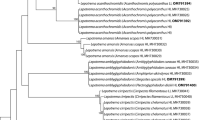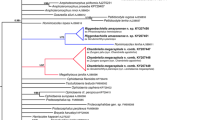Abstract
New material from Epinephelus quoyanus collected from Heron Island, Australia and material collected by Young in the same locality, allegedly from E. merra, and deposited in the Queensland Museum, contained the same three species of diplectanid monogeneans: Pseudorhabdosynochus cupatus (Young, 1969), P. vagampullum (Young, 1969), and P. justinei Zeng et Yang, 2007 (new record for Australia). In contrast, E. merra in New Caledonia harbours only P. melanesiensis (Laird, 1958). It is concluded that the type-host of P. cupatus and P. vagampullum is not E. merra, as indicated in Young (1969), but E. quoyanus, and that P. cupatus sensu Young comprises two species, P. cupatus from E. quoyanus and P. youngi sp. nov. from E. fasciatus. P. youngi sp. nov. is described from E. fasciatus from New Caledonia (type-locality), Heron Island, and French Polynesia, and distinguished from P. cupatus on the basis of the male quadriloculate organ, sclerotised vagina and lamellosquamodiscs. Thus, P. cupatus, P. melanesiensis and P. youngi each have a single host, respectively E. quoyanus, E. merra, and E. fasciatus. Results for E. fasciatus and E. merra in New Caledonia, Wallis and French Polynesia suggest impoverishment of the monogenean fauna in a West-East gradient in the Pacific.
Résumé
Du matériel nouveau extrait de Epinephelus quoyanus récolté à Heron Island, Australie et le matériel collecté par Young dans la même localité, prétendument de E. merra, et déposé au Queensland Museum, contenaient les mêmes trois espèces de Monogènes Diplectanidae, à savoir Pseudorhabdosynochus cupatus (Young, 1969), P. vagampullum (Young, 1969) et P. justinei Zeng et Yang, 2007 (nouvelle mention pour l’Australie). De manière opposée, E. merra en Nouvelle-Calédonie héberge seulement P. melanesiensis (Laird, 1958). Il en est conclu que l’hôte-type de P. cupatus et P. vagampullum n’est pas E. merra, comme indiqué par Young (1969), mais E. quoyanus, et que P. cupatus sensu Young comprend deux espèces, P. cupatus de E. quoyanus et P. youngi sp. nov. de E. fasciatus. P. youngi sp. nov. est décrit de E. fasciatus de Nouvelle-Calédonie (localité-type), de Heron Island (Australie) et de Polynésie Française, et est distingué de l’espèce proche P. cupatus sur la base de l’appareil copulateur male tétraloculé, du vagin sclérifié et des lamellosquamodisques. De ce fait, P. cupatus, P. melanesiensis et P. youngi ont chacun un seul hôte, respectivement E. quoyanus, E. merra et E. fasciatus. Des résultats sur E. fasciatus et E. merra en Nouvelle-Calédonie, Wallis et Polynésie Française suggèrent un appauvrissement de la faune des Monogènes le long d’un gradient Ouest-Est dans le Pacifique.
Similar content being viewed by others
References
Angus B.M., Cannon L.R.G., Adlard R.D. 2007. Parasitology and the Queensland Museum with biographical notes on collectors. Memoirs of the Queensland Museum, 53, 1–156.
Bellwood D.R., Hughes T.P. 2001. Regional-scale assembly rules and biodiversity of coral reefs. Science, 292(5521), 1532–1534. DOI: 10.1126/science.1058635.
Beverley-Burton M., Suriano D.M. 1981. A revision of Cycloplectanum Oliver, 1968 (Monogenea: Diplectanidae) and descriptions of C. hongkongensis n. sp. and C. lantauensis n. sp. from Epinephelus spp. (Serranidae) in the South China Sea. Canadian Journal of Zoology, 59, 1276–1285.
Craig M.T., Hastings P.A. 2007. A molecular phylogeny of the groupers of the subfamily Epinephelinae (Serranidae) with a revised classification of the Epinephelini. Ichthyological Research, 54, 1–17. DOI: 10.1007/s10228-006-0367-x.
Cribb T.H., Pichelin S., Dufour V., Bray R.A., Chauvet C., Faliex E., Galzin R., Lo C.M., Lo-Yat A., Morand S., Rigby M.C., Sasal P. 2000. Parasites of recruiting coral reef fish larvae in New Caledonia. International Journal for Parasitology, 30, 1445–1451. DOI: 10.1016/S0020-7519(00)00121-1.
Heemstra P.C., Randall J.E. 1993. FAO Species Catalogue. Vol. 16. Groupers of the world (Family Serranidae, Subfamily Epinephelinae). An annotated and illustrated catalogue of the grouper, rockcod, hind, coral grouper and lyretail species known to date. FAO Fisheries Synopsis, No. 125, Volume 16. FAO, Rome, 382 pp.
Hinsinger D.D., Justine J.-L. 2006a. Pseudorhabdosynochus venus n. sp. (Monogenea: Diplectanidae) from Epinephelus howlandi (Perciformes: Serranidae) off New Caledonia. Systematic Parasitology, 63, 155–160. DOI: 10.1007/s11230-005-9012-8.
Hinsinger D.D., Justine J.-L. 2006b. The ‘Pseudorhabdosynochus cupatus group’ (Monogenea: Diplectanidae) on Epinephelus fasciatus, E. howlandi, E. rivulatus and E. merra (Perciformes: Serranidae) off New Caledonia, with descriptions of Pseudorhabdosynochus cyathus n. sp. and P. calathus n. sp. Systematic Parasitology, 64, 69–90. DOI: 10.1007/s11230-005-9018-2.
Justine J.-L. 2005a. Species of Pseudorhabdosynochus Yamaguti, 1958 (Monogenea: Diplectanidae) from Epinephelus fasciatus and E. merra (Perciformes: Serranidae) off New Caledonia and other parts of the Indo-Pacific Ocean, with a comparison of measurements of specimens prepared using different methods, and a description of P. caledonicus n. sp. Systematic Parasitology, 62, 1–37. DOI: 10.1007/s11230-005-5480-0.
Justine J.-L. 2005b. Pseudorhabdosynochus hirundineus n. sp. (Monogenea: Diplectanidae) from Variola louti (Perciformes: Serranidae) off New Caledonia. Systematic Parasitology, 62, 39–45. DOI: 10.1007/s11230-005-5481-z.
Justine J.-L. 2007. Parasite biodiversity in a coral reef fish: twelve species of monogeneans on the gills of the grouper Epinephelus maculatus (Perciformes: Serranidae) off New Caledonia, with a description of eight new species of Pseudorhabdosynochus (Monogenea: Diplectanidae). Systematic Parasitology, 66, 81–129. DOI: 10.1007/s11230-006-9057-3.
Justine J.-L. 2008. Pseudorhabdosynochus inversus sp. nov. (Monogenea, Diplectanidae) from the halfmoon grouper Epinephelus rivulatus (Perciformes, Serranidae) off New Caledonia. Acta Parasitologica, 53, 339–343. DOI: 10.2478/s11686-008-0057-0.
Justine J.-L. 2009. A redescription of Pseudorhabdosynochus epinepheli (Yamaguti, 1938), the type-species of PseudorhabdosynochusYamaguti, 1958 (Monogenea, Diplectanidae), and the description of P. satyui n. sp. from Epinephelus akaara off Japan. Systematic Parasitology, 72, 27–55. DOI: 10.1007/s11230-008-9171-5.
Justine J.-L., Vignon M. 2009. Monogeneans of the grouper Epinephelus tauvina (Perciformes: Serranidae) off Moorea, French Polynesia, with a description of Pseudorhabdosynochus pai n. sp. (Monogenea: Diplectanidae). Systematic Parasitology, 73, 113–125. DOI: 10.1007/s11230-008-9159-1.
Karlson R.H., Cornell H.V., Hughes T.P. 2004. Coral communities are regionally enriched along an oceanic biodiversity gradient. Nature, 429(6994), 867–870. DOI: 10.1038/nature02685.
Laird M. 1958. Parasites of South Pacific fishes II. Diplectanum melanesiensis n. sp., a monogenetic trematode from Fiji and the New Hebrides. Canadian Journal of Zoology, 36, 167–173.
Marie A.D., Justine J.-L. 2005. Monocotylids (Monogenea: Monopisthocotylea) from Aetobatus cf. narinari off New Caledonia, with a description of Decacotyle elpora n. sp. Systematic Parasitology, 60, 175–185. DOI: 10.1007/s11230-004-6345-7.
Oliver G., Paperna I. 1984. Diplectanidae Bychowsky, 1957 (Monogenea, Monopisthocotylea), parasites de Perciformes de Méditerranée orientale, de la mer Rouge et de l’océan Indien. Bulletin du Muséum National d’Histoire Naturelle, Paris, 4°Série, 6, Section A(1), 49–65.
Plaisance L., Littlewood D.T.J., Olson P.D., Morand S. 2005. Molecular phylogeny of gill monogeneans (Platyhelminthes, Monogenea, Dactylogyridae) and colonization of Indo-West Pacific butterflyfish hosts (Perciformes, Chaetodontidae). Zoologica Scripta, 34, 425–436. DOI: 10.1111/j.1463-6409.2005.00191.x.
Young P.C. 1968. Ten new species of Haliotrema Johnston and Tiegs, 1922 (Monogenoidea: Dactylogyridae) from Australian fishes and a revision of the genus. Journal of Zoology, London, 154, 41–75.
Young P.C. 1969. Some monogenoideans of the family Diplectanidae Bychowsky, 1957 from Australian teleost fish. Journal of Helminthology, 43, 223–254.
Zeng B., Yang T. 2007. Description of Pseudorhabdosynochus justinei n. sp. (Monogenea: Diplectanidae) and redescription of P. vagampullum (Young, 1969) Kritsky & Beverley-Burton, 1986 from the gills of the longfin grouper Epinephelus quoyanus (Valenciennes) (Perciformes: Serranidae) in Dapeng Bay, South China Sea. Systematic Parasitology, 66, 223–225. DOI: 10.1007/s11230-006-9067-1.
Author information
Authors and Affiliations
Corresponding author
Rights and permissions
About this article
Cite this article
Justine, JL., Dupoux, C. & Cribb, T.H. Resolution of the discrepant host-specificity of Pseudorhabdosynochus species (Monogenea, Diplectanidae) from serranid fishes in the tropical Indo-Pacific. Acta Parasit. 54, 119–130 (2009). https://doi.org/10.2478/s11686-009-0027-1
Accepted:
Published:
Issue Date:
DOI: https://doi.org/10.2478/s11686-009-0027-1




